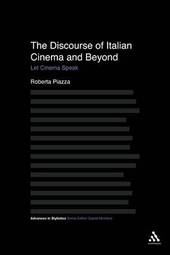
|
The Discourse of Italian Cinema and Beyond: Let Cinema Speak
Hardback
Main Details
| Title |
The Discourse of Italian Cinema and Beyond: Let Cinema Speak
|
| Authors and Contributors |
By (author) Roberta Piazza
|
| Series | Advances in Stylistics |
|---|
| Physical Properties |
| Format:Hardback | | Pages:272 | | Dimensions(mm): Height 234,Width 156 |
|
| Category/Genre | Film theory and criticism
Semantics |
|---|
| ISBN/Barcode |
9781441136978
|
| Classifications | Dewey:791.430945 |
|---|
| Audience | | Professional & Vocational | |
|---|
|
Publishing Details |
| Publisher |
Continuum Publishing Corporation
|
| Imprint |
Continuum Publishing Corporation
|
| Publication Date |
14 February 2011 |
| Publication Country |
United States
|
Description
Roberta Piazza's book is a linguistic investigation of the dialogue of Italian cinema covering a selection of films from the 1950s to the present day. It looks at how speech is dealt with in studies of the cinema and tackles the lack of engagement with dialogue in film studies. It explores the representation of discourse in cinema -- the way particular manifestations of verbal interaction are reproduced in film. Whereas 'representation' generally refers to the language used in texts to assign meaning to a group and its social practices, here discourse representation more directly refers to the relationship between real-life and cinematic discourse. Piazza analyses how fictional dialogue reinterprets authentic interaction in order to construe particular meanings. Beginning by exploring the relationship between discourse and genre, the second half of the book takes a topic-based approach and reflects on the themes of narrative and identity. The analysis carried out takes on board the multi-semiotic and multimodal components of film discourse. The book uses also uses concepts and methodologies from pragmatics, conversation analysis and discourse analysis.
Author Biography
Roberta Piazza is Reader in Linguistics and English Language at the University of Sussex, UK.
ReviewsThe Discourse of Italian Cinema and Beyond joins a growing body of work that is taking forward work in stylistics by expanding not only the subject of analysis, from poetry and prose fiction to film and television, but also the set of methods in acknowledging the visual alongside the verbal. While Piazza herself is modest in speculating how her investigation might contribute to the study of film within media and cultural studies, this truly interdisciplinary work is a clear contribution to both stylistics and film studies. Piazza's analyses are grounded equally well in linguistics and film theory, and this book stands as a relevant contribution to our knowledge of both discourse and the cinema. -- Susan Mandala, Department of Culture, University of Sunderland, UK * Discourse & Communication *
|